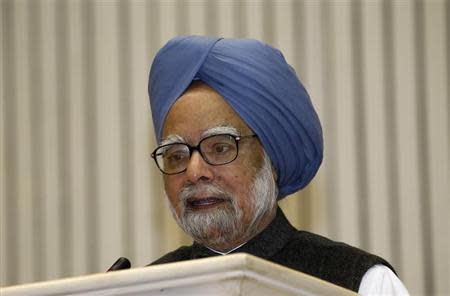Indian PM Singh says economy can weather rupee storm
By Frank Jack Daniel and Rafael Nam NEW DELHI/MUMBAI (Reuters) - India's prime minister sought to quell talk of currency crisis on Friday, after the rupee plumbed record lows as it notched its biggest ever monthly fall, but there was no word of sweeping reforms needed to restore investor confidence. Weak economic growth, a record high current account deficit and concerns about the government's finances are proving a toxic mix for the rupee, which hit a record low of 68.85 to the dollar on Wednesday after falling 20 percent since May. Dollar selling by the Reserve Bank of India, rather than Prime Minister Manmohan Singh's speech to parliament, helped pull the rupee out of a slide back towards the lows on Friday, but it has lost around 10 percent of its value in August alone, according to Thomson Reuters data. While global factors such as the potential end to U.S. stimulus and most recently tensions over Syria have sent emerging market currencies reeling, the scale of the rupee's decline is far greater than most. Singh said the currency's fall was a matter of concern, but dismissed doomsayers predictions for the Indian economy, insisting its fundamentals remained sound and its banking system was well capitalized above international requirements. "We need to ensure the fundamentals of the economy remain strong so that India continues to grow at a healthy rate for many years to come," the octogenarian prime minister told lawmakers in his first significant speech to parliament on the economy in months. "That we will ensure. We are no doubt faced with important challenges." Gross domestic product (GDP) data, due to be released after the markets close, is expected to show the economy grew 4.7 percent in the April-June quarter, the third consecutive quarter of sub-5 percent growth. India suffered decade-low growth of 5 percent in the fiscal year that ended in March, and many analysts surveyed by Reuters during the past week expect this year to be worse. Singh, a veteran economist who made his reputation as finance minister overseeing India's recovery from a balance of payments crisis in 1991, predicted growth would recover to 5.5 percent this fiscal year. With a national election due by May, Singh's minority government is under fire from all quarters to come up with meaningful reforms, including a possible increase in diesel prices, that would lower the subsidy burden. He said the government would need to find ways to reduce imports of gold and oil products to reduce the trade gap, and he put a gloss on the rupee's depreciation by saying it would help make exports more competitive and reduce imports. By mid-afternoon, the RBI's intervention had helped the rupee recover to 66.25 per dollar from an earlier low of 67.43, to stand a touch stronger than Thursday's close of 66.55. ELECTION LOOMING Singh's liberalization of a moribund economy in 1991 provided the platform for 20 years of rapid economic growth, and he has been credited as the architect of India's emergence as a serious economic power. But now he is being pilloried for lost opportunities to make further reforms during his nine years as prime minister. While few economists believe India's problems could become as great as they were in 1991, there is broad agreement that the country needs reforms on a similar scale to open up its markets. "My concern is that with the election still a few months away we're are not going to get the sort of reforms that the country needs," said Peter Elston, head of Asia-Pacific strategy and asset allocation at Aberdeen Asset Management in Singapore. "All we're going to get is the reforms that are not long-term oriented, but just designed to win votes, like the food bill." Parliament passed this week a 1.35 trillion rupees ($20.21 billion) plan to provide subsidized grains to the poor that raised concerns about spending. Fears that the government will fail to meet its target of bring its fiscal deficit down to 4.8 percent of GDP this year were heightened by data released on Friday. During the first four months of this fiscal year the deficit had reached close to 63 percent of the full-year target. Revenues were just 16 percent of the target, while spending stood at 31.3 percent of the target. On Thursday, the government approved a land acquisition act that protects farmers interests by letting them get up to four times the market rate for their land, raising doubts over how much the law would help investment in infrastructure and industrial projects. NEW DEFENDER Raghuram Rajan, a former chief economist at the International Monetary Fund, is set to take over leading the defense of rupee when he steps into his new role as RBI governor next Thursday. The RBI's strategy has rested on draining cash from domestic money markets and raising short-term interest rates, but that has made it more costly for struggling corporates to raise money, putting another brake on growth. The central bank is considering a radical plan to cut gold imports, the second biggest item after oil on the import bill, a source familiar with the RBI's thinking told Reuters, The proposal, which has met with some skepticism, would see commercial banks buy gold from ordinary citizens and sell to precious metal refiners. ($1 = 66.7900 Indian rupees) (Additional reporting by Himank Sharma in Mumbai; Editing by Simon Cameron-Moore)

